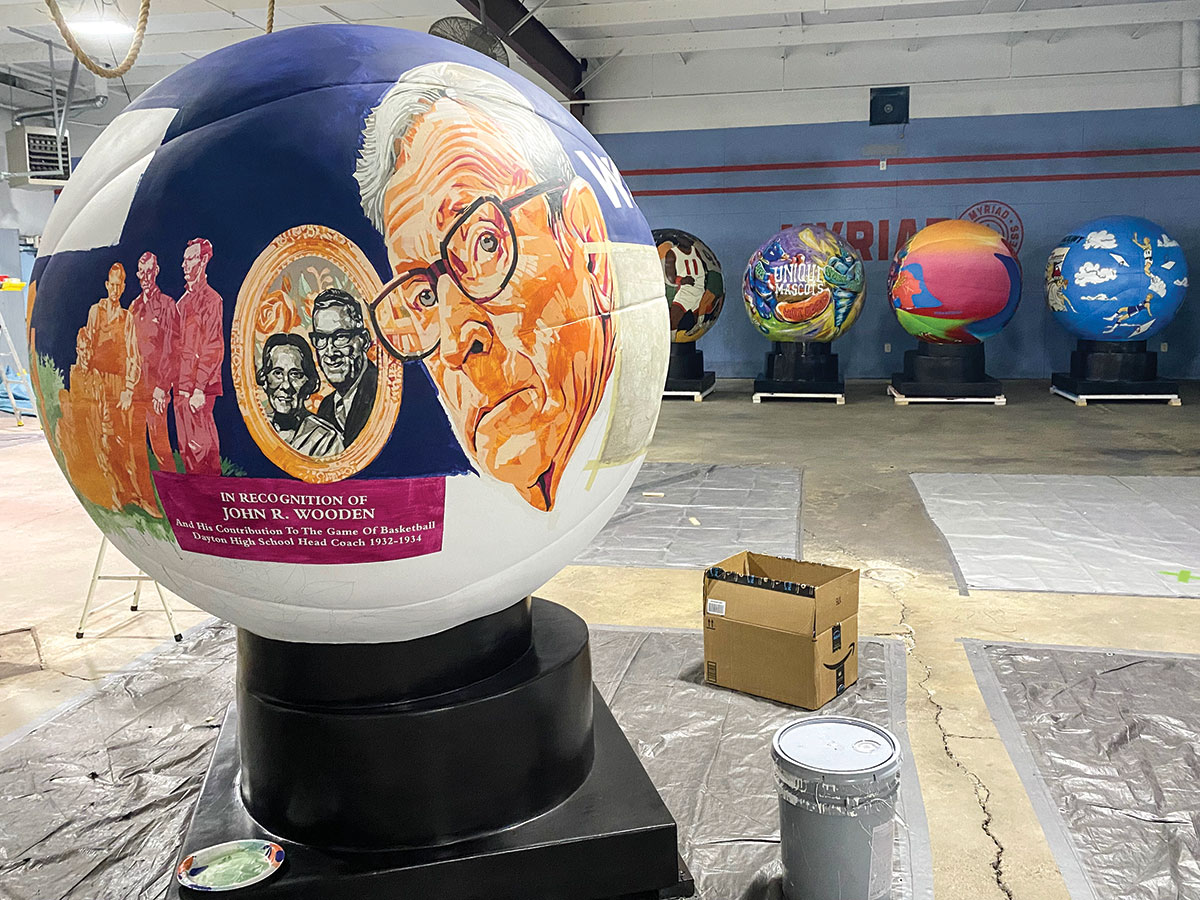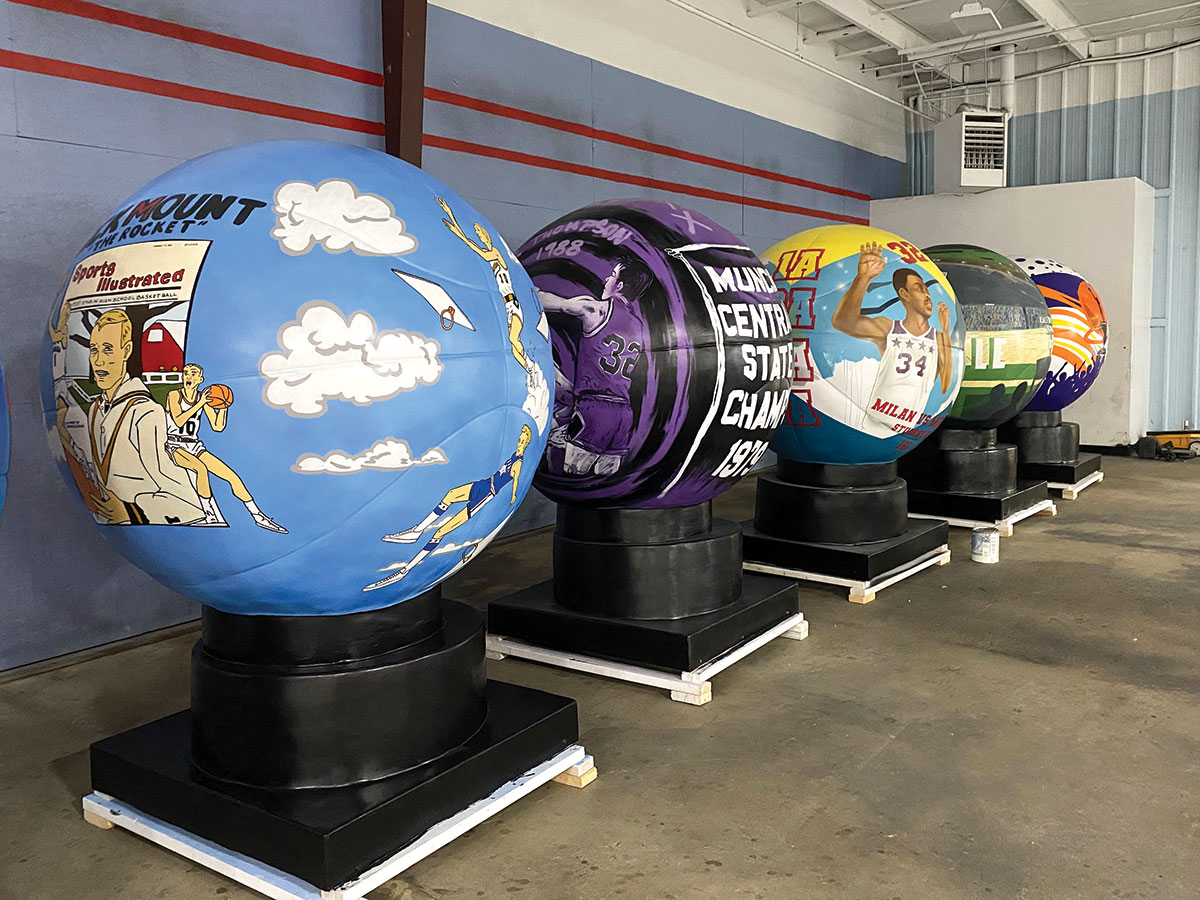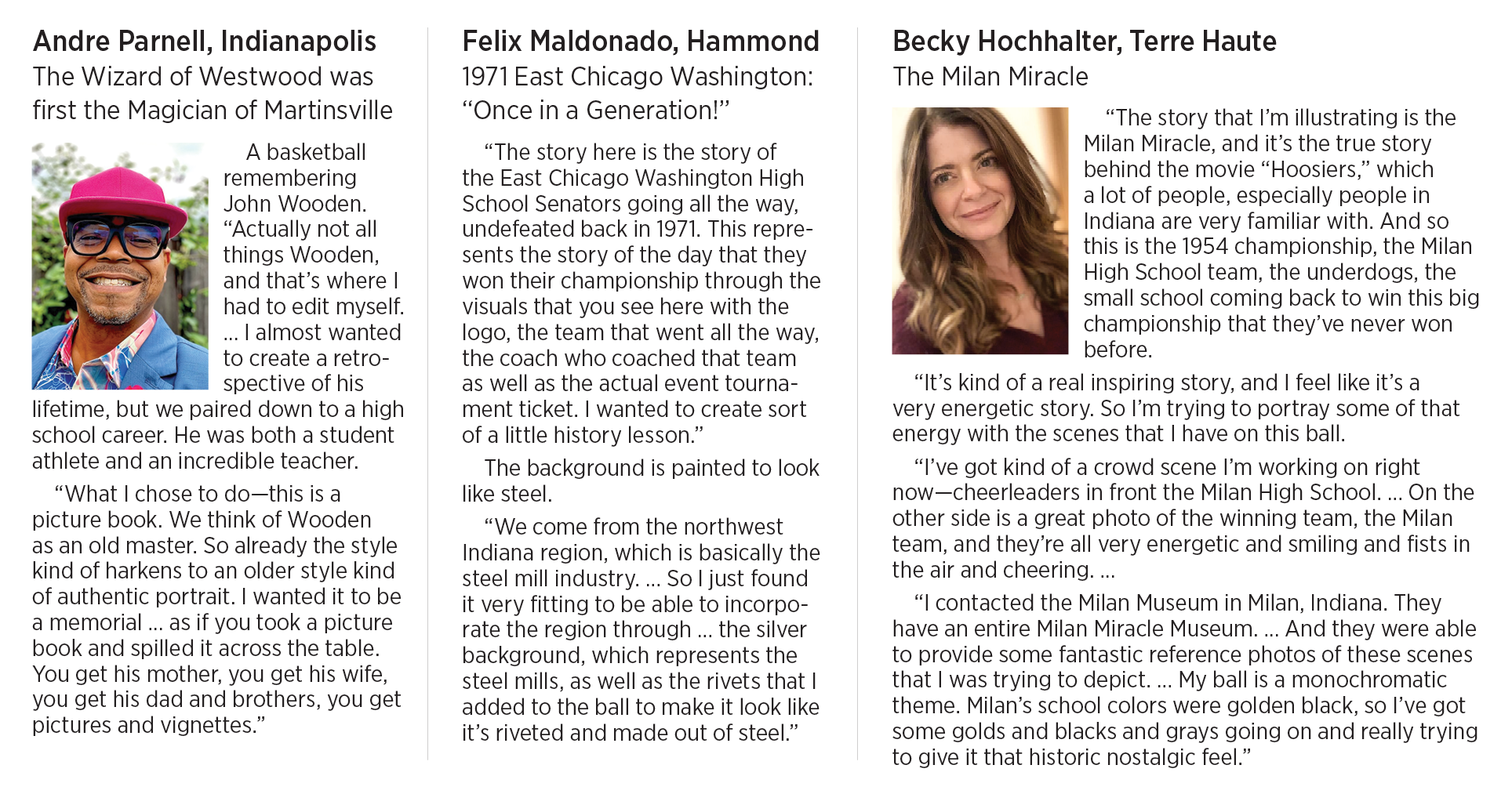Subscriber Benefit
As a subscriber you can listen to articles at work, in the car, or while you work out. Subscribe Now
(IBJ photo/Dave Lindquist)
At least as far back as the 2012 Super Bowl, Indianapolis has built a reputation not just for its excellence in stitching together all of the elements of large sports events but also for finding ways to weave the work of local artists and craftspeople into the fabric of the event.
For the NBA All-Star Weekend, local organizers hit on a way to put a distinctly Hoosier spin on the areas downtown that will host the most visitors, playing off of the concept of Hoosier Hysteria.
Here’s the idea: Create 24 giant fiberglass basketballs that would act as blank canvases for 24 artists. On the balls, they would paint scenes relating to the people, places and specific games we most associate with Hoosier Hysteria.
Obviously, the Milan Miracle is on the list—the 1954 state championship that inspired the movie “Hoosiers.” And there’s a ball dedicated to the legendary 1955 champions from Crispus Attucks High School—the first all-Black squad to win an open state championship in the nation. You’ll also see balls referencing the annual Indiana-Kentucky game, the effect of Title IX on high school basketball and the never-ending debate over class basketball.
The project is called Hoosier Historia. And for a recent episode of the IBJ Podcast, host Mason King went to the warehouse where artists were working on their pieces before being deployed—23 in the Mile Square and one at Indianapolis International Airport—to talk to several of the artists and organizer Julia Muney Moore, director of public art at the Arts Council of Indianapolis.
This is an excerpt of King’s conversation with Moore as well as some snippets from his conversations with three of the artists.
Mason King: Tell listeners where we are and what we see in this cavernous space.
Julia Muney Moore: We are in a warehouse in downtown Indianapolis, right next to the Stutz Building, and you are surrounded by very large basketball sculptures, some of which are in the process of being painted, some of which are completed. And this is all for the Hoosier Historia project related to the NBA All-Star event.
King: When will these be deployed downtown?
Moore: Between the 14th and the 15th of February, and we have very little time to set out 24 sculptures in several large trucks, and we’ll do the best we can in downtown traffic.
You can find them at all of the All-Star venues. So you’ll be able to find them at the convention center, at Gainbridge Fieldhouse, at Lucas Oil Stadium. But you’ll also be able to find them along Washington Street. You’ll see several of them on Meridian Street, on Illinois Street, and then you’ll also see them on the southern half of Monument Circle and other places around town. There will be one at the airport; there will be one at the Transit Center. So as you’re coming downtown, you’ll run into them.
King: So Julia, how did this come about? Was this something that was originally planned for the 2021 All-Star Game, or did this idea germinate after [the Indianapolis hosting duties were rescheduled] to 2024?
Moore: After the host committee team had gone and seen a couple of different ways that other cities had hosted the game, they came back and said: How can we make this spectacular? And one of the things that they thought that we needed to do is to tell stories about why basketball is so special in Indiana when it’s just a game anywhere else.
And the best way to do that is to tell the stories in a way that’s really going to grab people emotionally, rather than just in a social media post. I mean, it has to be big. If you notice, these are larger than people size. And when you’re confronted with something that big right in your face and it’s a story that you feel very emotionally connected to, that’s going to extend to the entire surrounding event.
And that’s how they hit upon this particular sculpture. I mean, we talked about other things. We talked about some murals … but the idea of having these sculptures made and making them physical where you can walk around it and you can’t just pass by them because they are obvious. And then also having people learn. I mean, most people that are coming here do not know all of the stories. … They know maybe Crispus Attucks. They know maybe the Milan Miracle because of “Hoosiers.” But beyond that, if they’re not from here, they don’t know what it means. And this is what we wanted to show.
King: What are these made out of?
Moore: They’re made fiberglass. They’re molded and then the pieces are attached together. … And then they are coated with a primer.
King: They needed to be custom made?
Moore: They did. So the place that we’re getting them done, it’s in Nebraska, it’s called Fiberglass Animals and Objects. … It’s a small family-owned business, which is really interesting that the way that they’re able to turn out the volume, it is a very small operation, but they do amazing work. I mean, they produce [fiberglass animals] for all kinds of projects. But they didn’t have a basketball, so this was absolutely 100% custom.
They’re 110 pounds, but when we put them out on the street, there’s a tray that gets filled with sandbags and then the sculpture gets bolted on top of it. So it’s going to exceed 300 pounds when it’s out.
King: And was this specifically a project of the Arts Council of Indianapolis?
Moore: This was generated by the NBA All-Star Host Committee. And it is a joint effort of the Indiana Pacers and the Capital Improvement Board. So they jointly funded it, and at the end of the project, the Capital Improvement Board is going to own the sculptures. Then they can do whatever they want with it.
I believe that the schools that are represented in these stories have the first right of refusal for receiving their sculptures. So if Muncie Central wants theirs, if Franklin wants the one about the Franklin Wonder Five, they can absolutely come and get it, take it away, and the CIB will transfer ownership.
King: What was the budget for this whole project?
Moore: It was over $200,000.
King: The artist commission was $6,000?
Moore: The total was $200,000 because commissioning the sculptures was one fee. The artist fees are another. We have some costs such as hiring the trucks to transport them and set them around. We had some other expenses. We had some expense budgeted for the warehouse space. … But the two biggest expenses were purchasing the sculptures and paying the artists.

King: So a call went out to recruit artists. What would make an artist eligible for this project?
Moore: Well, they had to have a really strong connection to Indiana. So living here now, lived here previously, grew up in Indiana, went to high school in Indiana, those kinds of things. So we really didn’t want someone coming from outside Indiana with their own idea of what Indiana high school basketball was about. We really wanted people who felt it because they were from here.
I’m not from here, so in a certain sense I don’t feel it, but it’s not my job. I’m not painting these. I’m here to just make sure that everybody else feels that.
One of the things that we wanted to make sure is that the artists brought a sense of interpretation, that they weren’t just going to take, oh, here’s a photograph that was in the newspaper of the shot that won a particular game or here is a portrait of this individual who won the first Indiana Mr. Basketball. Because those are very, very easily accessible. …
We wanted artists who would bring their own interpretation, their own history, their own sense of composition and their own ideas of what they felt was the most interesting and important part of the story.
King: You would accept or look at an artist who didn’t live in Indiana if they went to high school in Indiana? Correct.
Moore: We had applicants [from outside Indiana]; they did not make it to the final 24.•
Please enable JavaScript to view this content.

